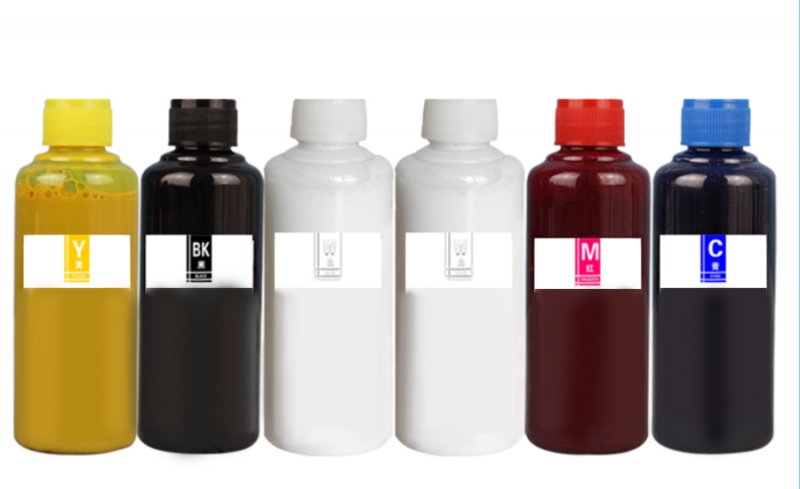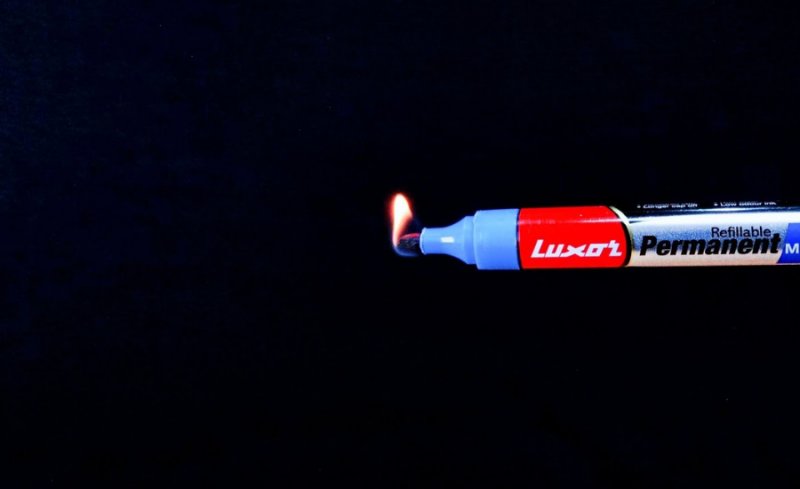The Burning Question: Is Ink Flammable? A Comprehensive Analysis
Throughout history, ink has been utilized since at least the 26th century BC for various writing and drawing purposes. Even today, its use remains widespread and versatile, enabling us to write letters, print posters, create tattoos, and more.
Have you ever pondered whether ink could potentially be a fire hazard? We’ll discuss ink’s flammability here. First, ink’s chemical makeup. Next, Hint will distinguish combustible and flammable compounds. Finally, we’ll delve into the relationship between ink and the risk of fire.
What Constitutes the Chemical Makeup of Ink?

Dye, surfactants, resins, lubricants, and other ingredients make up ink, a fascinating substance. However, its primary foundation is a dye that gets mixed with a solvent. This combination is then applied to surfaces like paper, fabric, or skin. The solvent evaporates, leaving the dye color on the surface to create the image or words.
The thickness, flow, and appearance of dried ink depend on its colorants, solvent, and additions. Ink is widely utilized to create images, texts, and designs in a multitude of applications.
Interestingly, the global consumption of ink results in a substantial revenue of more than 20 billion dollars. Although the demand for ink in traditional print media may be decreasing, it is experiencing a surge in usage for packaging purposes.
Overall, ink is an indispensable medium that continues to find innovative applications in modern society, making it an integral part of our daily lives.
Is Ink Flammable?
Certainly! Depending on its composition, ink can burn. Water-based and non-water-based inks are the main types. The non-flammable water-based ones use water as their solvent. Non-water-based inks employ hydrocarbons to deliver dye and are frequently combustible.
A hydrocarbon is an organic substance with solely hydrogen and carbon. They’re in petroleum, natural gas, and coal. Because their carbon is reduced, hydrocarbons are very flammable. This renders it reactive and easily oxidized by oxygen.
Hydrocarbon molecules evaporate and spread fast. They’re flammable because their flames spread quickly.
Many inks employ non-water-based solvents like alcohol, acetone, and benzene. Inks manufactured with hydrocarbon solvents are combustible.
Water-based inks use water as a solvent to convey pigment. These connections aren’t flammable. Most inks are only flammable when wet, but after the solvent dries, they are no longer flammable.
In conclusion, ink’s flammability relies on its composition. Non-water-based inks, especially those with hydrocarbons, can be combustible until they dry.
Flammable vs Combustible

“Finance” describes a commodity or service. Some people think “flammable” indicates something will catch fire and “combustible” means it will explode when ignited, but that’s only partially true. 29 CFR 1910 of OSHA defines flammable liquids.
Flammable liquids have flashpoints below 199.4 degrees Fahrenheit (93 degrees Celsius).
Flashpoint: The lowest temperature at which a substance emits enough vapor to catch fire.
Importantly, liquids and solids don’t burn. They emit fumes that can ignite at certain temperatures.
Flammable liquids are more dangerous since they can catch fire at lower temperatures. Other liquids can also burn. Flammable and non-flammable liquids can spark flames at different temperatures.
All liquids can catch fire, but their flammability depends on their features and flashpoints.
What Will Burn in the Ink?
For different purposes, ink might vary greatly. The ink used in fountain pens, ballpoint pens, printers, and tattoos differs. Which inks are flammable? Inks can be water-based or not.
Inks function by mixing a dye or pigment with a solvent, which carries the color. This ink solution is printed or pressed onto paper, fabric, or other materials. The solvent evaporates from the ink, leaving the dye for usage.
Water-based inks carry dye with water. Unless combustible chemicals are added, these inks are nonflammable because water is the solvent.

Non-water-based inks contain alcohols, acetone, MEK, Naptha, pentane, hexane, mineral oil, benzene, toluene, esters, and ethers.
In most solve some hydrocarbons burn easily. Many non-water-based inks are very flammable, depending on the hydrocarbon content.
As the solvent evaporates during drying, some inks are only combustible when wet. Non-water-based inks can burn after drying.
As a result of their usage of volatile hydrocarbon solvents, several non-water-based inks can cause fires. Ink flammability depends on its components and hydrocarbon content.
Are Inks Not Based on Water Flammable?
Non-water-based inks can indeed be volatile and have a higher risk of catching fire easily. Most of these inks contain hydrocarbons, hydrogen-carbon molecules. Most substances are flammable hydrocarbons. They burn and explode.
Hydrocarbons in these inks make them more flammable. As a result, it is crucial to handle and store these inks with care to avoid any fire hazards. Understanding the flammability of these inks can help ensure proper safety measures are taken when working with them.
What Are The Various Forms Of Ink?

Water-based inks use water as the solvent to transfer color or dye to a surface. Chemical-based inks use solvents including ethyl acetate, alcohols, and mineral oil.
Hydrocarbon-based inks are combustible. Hydrocarbons are highly ignitable carbon-hydrogen compounds. Chemical-based ink is more prone to catch fire under certain situations. Hydrocarbons burn easily.
The likelihood of ink igniting depends on the amount of hydrocarbons present in the ink. When water is the primary solvent, the ink becomes less flammable, unless other potent additives are mixed in. However, water-based ink is less common than different types.
In general, many inks are only flammable while wet because the solvent evaporates during the drying process. But this isn’t always the case; some inks can remain flammable even after drying.
Considering the potential risks, it’s essential to conduct health and safety evaluations when using any type of ink to minimize additional dangers.
Remember, if you don’t see a clear list of elements used in the ink and water isn’t mentioned, it’s best to assume that the ink may be flammable! Being cautious and aware of the ink’s composition can help ensure safe usage.
When Will Ink Burn at What Temperature?
The ink will release vapors if the temperature is below 199.4 degrees Fahrenheit, and if these fumes come into touch with a flame, the ink can catch fire immediately. Therefore, it’s imperative to handle ink carefully. Normally, you can find this information, along with specifications about the ingredients used, on the ink bottle to indicate whether it is flammable or not.

“Flashpoint” is a further phrase that is crucial to comprehend. This is the lowest temperature at which a substance can emit easily ignitable vapors. As a result, it is evident from the information above that depending on their flashpoint, flammable liquids like ink can ignite very quickly.
It’s crucial to be aware of the potential flammability of ink and adopt the appropriate safety measures when using or storing it in order to ensure safety. Checking the packaging and understanding the ingredients and flashpoints can provide valuable insights to handle ink responsibly and prevent accidents.
Can Solvent Ink Fire Flame?
Many hydrocarbons have low flash points and can ignite. Benzene ignites at -11°C, ethyl acetate at -4°C, and toluene at 6°C. Solvent ink includes hydrocarbons, which are combustible at 93 degrees Celsius.
If a fountain pen or printer ink cartridge doesn’t have a label, presume it’s flammable.
Combustible materials burn above 93 degrees Celsius. For instance, paper is considered a combustible material. Additionally, liquids like diesel and fuel are examples of combustible materials.
Given this information, we should treat ink as a hazardous substance that must never be exposed to open flames or any potential ignition source. It’s crucial to handle ink with extreme caution to avoid any fire-related accidents. Working with combustible materials like ink requires safety precautions.
Is Ink Hazardous

The type and use of ink can pose risks. Inks with toxic compounds can harm humans and the environment if handled improperly. Toner ink, for instance, may include VOCs that are harmful if inhaled.
In addition, tattoo and permanent cosmetics inks may contain lead, mercury, and cadmium. Metals can cause skin irritation, allergies, and other health difficulties.
Read ink product labels and safety data sheets to ensure safety. Avoiding dangers requires careful handling and disposal. To avoid dangerous compounds, utilize sufficient ventilation and PPE Being aware of the ink we use can help protect us and the environment from toxic inks.
Is Printer Ink Flammable
Depending on type and composition, printer ink can burn. Inkjet printers employ non-flammable water-based inks. These inks contain water, dyes or pigments, and a little alcohol or glycol for drying. Thus, they are safe and fire-safe.
Large-format printers use flammable solvent-based inks. Burning these inks releases hazardous VOCs.
Handle and store printer ink safely. It should be stored in a well-ventilated area away from heat, sparks, and flames.
per avoid dangers, dispose of ink cartridges and other ink-related debris according per manufacturer recommendations.
By understanding printer ink flammability and taking care, we may use them safely and reduce fire risks.
Safety Measures and Regulations
Ink flammability requires proper safety measures and regulations to prevent accidents and protect people and the environment. Below are essential guidelines to handle ink safely:
Proper Storage: Store ink containers in well-ventilated areas away from direct sunlight, ignition sources, and heat. Segregate flammable and combustible inks from other materials to minimize potential risks.
Fire Prevention: Take preventive measures to avoid ink-related fires. This includes regular maintenance of printing equipment, ensuring no leakages or spillages, and keeping ignition sources away from ink storage areas.
Ventilation: Ensure proper ventilation in areas where ink is handled, mixed, or used. Adequate ventilation helps disperse any volatile fumes, reducing the risk of fire.
Personal Protective Equipment (PPE): Provide appropriate PPE to workers handling ink, such as gloves, safety glasses, and protective clothing. This safeguards against accidental skin contact or inhalation of hazardous substances.

Fire Suppression Equipment: Install fire extinguishers and fire suppression systems in locations where ink is stored or used. Employees should be trained in their proper usage.
Safety Training: Conduct regular safety training sessions for employees working with ink. Train them on handling procedures, emergency response, and the proper use of fire safety equipment.
Emergency Plans: Develop and communicate clear emergency response plans in case of an ink-related incident. Ensure all employees know evacuation routes and assembly points.
Labeling and Signage: Properly label all ink containers with relevant information, including flammability warnings and handling instructions. Use clear and visible signage to identify flammable ink storage areas.
Compliance with Regulations: Stay up-to-date with local, national, and international regulations related to ink flammability. Maintain workplace safety by following industry standards.
Material Compatibility: Ensure that ink storage containers are made of compatible materials that can withstand the specific ink’s properties and prevent chemical reactions.
Static Electricity Control: Implement measures to control static electricity in areas with flammable inks, as static discharge can ignite vapors.
Spill Response: Establish spill response protocols to quickly and effectively handle ink spills. Provide spill kits with appropriate absorbent materials and train employees in their usage.
Regular Inspections: Conduct routine inspections of ink storage areas and equipment to identify and address potential safety hazards.
Safe Handling Procedures: Instruct employees on the safe handling, transportation, and disposal of inks to prevent accidents and environmental contamination.
Designated Smoking Areas: Prohibit smoking in areas where ink is stored or used, as cigarettes and other smoking materials can be a potential ignition source.
Individuals and organizations can limit ink flammability concerns and create a safe working environment by following certain safety procedures and regulations.
Historical Incidents: Ink Flammability in the Past
Throughout history, there have been notable incidents that shed light on the flammability of ink and its potential risks. These incidents serve as crucial reminders of the importance of understanding and addressing ink flammability.
One such incident dates back to the 15th century, during the early years of printing using movable type and oil-based inks. The highly flammable nature of these inks, coupled with the use of open flames for heating, resulted in numerous devastating fires in printing workshops. These fires often led to the destruction of valuable manuscripts, and printing presses, and, tragically, the loss of lives. During this time, printers began to realize the need for safer ink formulations and improved fire safety practices.
Ink flammability has caused industrial catastrophes in recent years. Solvent-based inks were widely used in printing, packaging, and textiles in the mid-20th century, creating additional flammability issues. Fires and explosions caused by improper storage, handling, or disposal of solvent-based inks damaged facilities and injured workers.
Additionally, the tattoo industry has also witnessed incidents involving flammable tattoo inks. Tattoo artists working with certain ink formulations that contained flammable solvents faced the risk of flash fires during tattooing procedures. These incidents raised concerns about the safety of tattoo inks and prompted the industry to develop safer ink alternatives.
Historical incidents have spurred research and safety improvements in ink manufacturing and handling processes. Water-based inks and non-flammable compounds have reduced ink-related fires. Moreover, increased awareness of safety protocols and the implementation of fire prevention measures have played a vital role in mitigating ink flammability risks across various industries.
Learning from these past incidents, modern regulations, and safety standards now guide the manufacturing, handling, and storage of inks, emphasizing the need to prioritize safety while using these materials. By understanding the historical context of ink flammability and the lessons learned from previous accidents, society can continue to make advancements in ink technology and safety practices, ensuring a safer environment for all individuals who interact with ink products.
Ink Flammability in Different Industries

Ink flammability is a major issue in many sectors that employ inks. Workers, customers, and the environment must be aware of ink dangers.
Traditional and digital printing use different inks with distinct flammability properties. Due to volatile solvents, solvent-based inks used in large-format, gravure, and flexographic printing are combustible. Mishandling or inappropriate disposal of solvent-based inks can cause fires, despite precautions. Water-based inks are less flammable and safer for some printing applications.
Markers, pens, and paints use inks in arts and crafts. Art materials use water-based inks, which are safer than solvent-based. However, certain speciality inks may include combustible components, requiring careful use and storage.
Tattoo ink flammability is another issue. Tattoo inks contain combustible pigments and carriers. Tattoo artists must know the components in their inks and take steps to avoid flash fires.
Water-based and solvent-based inks are used in packaging and labeling, too. Proper handling and storage reduce ink-related fires and accidents.
Printed circuit boards and flexible electronics use conductive inks. These inks include metal nanoparticles in a carrier media, therefore their flammability must be considered during manufacture and application.
Many sectors have switched to UV-curable inks, which don’t use volatile solvents and are safer. Digital printing, signs, and packaging use UV-curable inks.
Each industry must evaluate the flammability hazards of their inks and take precautions. Ink-related fires can be prevented and workplaces kept safe by following proper handling, storage, and disposal procedures and safety requirements.
Myths and Misconceptions
In the realm of ink flammability, several myths and misconceptions have circulated over time, leading to misunderstandings and potential safety risks. Let’s explore some of these common misconceptions and debunk them:
- All Inks Are Equally Flammable
All inks are not combustible, contrary to popular belief. In reality, the flammability of ink depends on its composition and the presence of volatile components like solvents. Water-based inks burn less. Understanding the differences between ink types can help individuals and industries make informed decisions regarding ink usage and safety protocols.
- Color Determines Flammability
Another misconception is that the color of the ink affects its flammability. Darker inks may be more flammable. Color doesn’t affect flammability. The ink’s chemical composition—including flammable solvents and additives—is critical. No of the hue, or ink should be handled safely.
By dispelling these myths and misconceptions, we can promote a better understanding of ink flammability and encourage responsible practices when handling and using inks. It is essential for individuals, industries, and educational institutions to be well-informed about ink properties, safety measures, and regulatory guidelines to minimize risks and ensure the safe handling of inks in various applications.
Handling Ink in Educational Settings
Educational ink handling must balance creativity and safety. Art classes, printing materials, and document production use ink in schools. Safeguarding kids, workers, and the environment requires specific practices.
Educators and staff must first understand educational inks. They should grasp the flammability hazards of each type and choose inks safely. Water-based inks may be safer than solvent-based ones.
Safe ink-handling education is also essential. Art teachers should teach pupils about ink storage, use, and disposal. Cleanliness and cautious handling can prevent accidents and make the classroom safe.
Labels should provide ink kind, handling instructions, and safety cautions. Inks should be stored in well-ventilated spaces away from heaters and open fires. Educators should check ink storage sites for dangers and rectify them immediately.
Students can also avoid ink exposure by using gloves and safety eyewear.
Educational institutions should have clear ink spill protocols. Absorbent materials and spill kits can assist contain a spill.
Finally, teaching ink safety helps promote careful handling. Students can study ink flammability and safety precautions. Discussing safety in the creative process can promote accountability and awareness.
These safety measures and ink safety instructions can help schools balance creativity and safety. Proper ink handling techniques safeguard people from potential threats and promote safety beyond the classroom.
Emergency Preparedness

Ink is flammable, thus emergency planning is essential. Ink emergencies can be mitigated by being prepared. Ink-using schools, companies, and other venues should have emergency preparations. These plans should include unambiguous ink-related fire and spill directions. All locals should know evacuation routes and assembly points.
To guarantee that students, employees, and staff know emergency protocols and can respond promptly and calmly in an emergency, fire drills, and training should be held often. Emergency scenarios can increase confidence and readiness for real-life crises. Fire drills should include ink spill training. This involves safely using spill kits and absorbent materials. To avoid ink component exposure, qualified people should clean up.
Fire extinguishers and suppression systems should be periodically inspected and maintained. Place fire extinguishers near ink storage and use. Having the right extinguisher for the fire is crucial. Emergencies require communication. Emergency communication is essential. Alarms, intercoms, and other technologies may be used to immediately communicate crucial information.
Having first aid and CPR-trained staff can also help ink-related emergencies. Accident outcomes can change with prompt and adequate medical care. Finally, debriefing following emergencies and drills helps discover areas for improvement. Participant input and emergency response evaluation can improve emergency preparedness and safety.
Ink-related emergencies can be handled rapidly with emergency preparedness and training, preventing injuries, property damage, and environmental contamination. Preparedness saves lives and makes work and school safer.
Frequently Asked Questions (FAQs) on Ink Flammability
Can all types of ink catch fire?
Not all inks burn. Ink’s flammability depends on its composition and solvents. Solvent-based inks are more flammable than water-based ones. UV-curable inks, which do not use volatile solvents, are less flammable.
Is ink flammability affected by color?
No, ink color does not affect flammability. Flammability depends on the ink’s chemicals, including flammable solvents and additions. Handle all ink safely, regardless of color.
How should I store inks to minimize fire risk?
Proper storage is crucial for minimizing the fire risk associated with inks. Store ink containers in well-ventilated areas away from direct sunlight, ignition sources, and heat. Segregate flammable inks from other materials and follow specific storage guidelines based on the type of ink used. Water-based inks are generally safer and may require less stringent storage measures compared to solvent-based inks.
Are water-based inks safer than solvent-based inks?
Yes, usually. Less flammable solvents make water-based inks safer. Water-based inks release water vapor instead of volatile organic chemicals, lowering fire risk. To guarantee a safe workplace, inks must be handled appropriately and safety requirements followed.
Stay in touch to get more updates & alerts on Hint! Thank you







